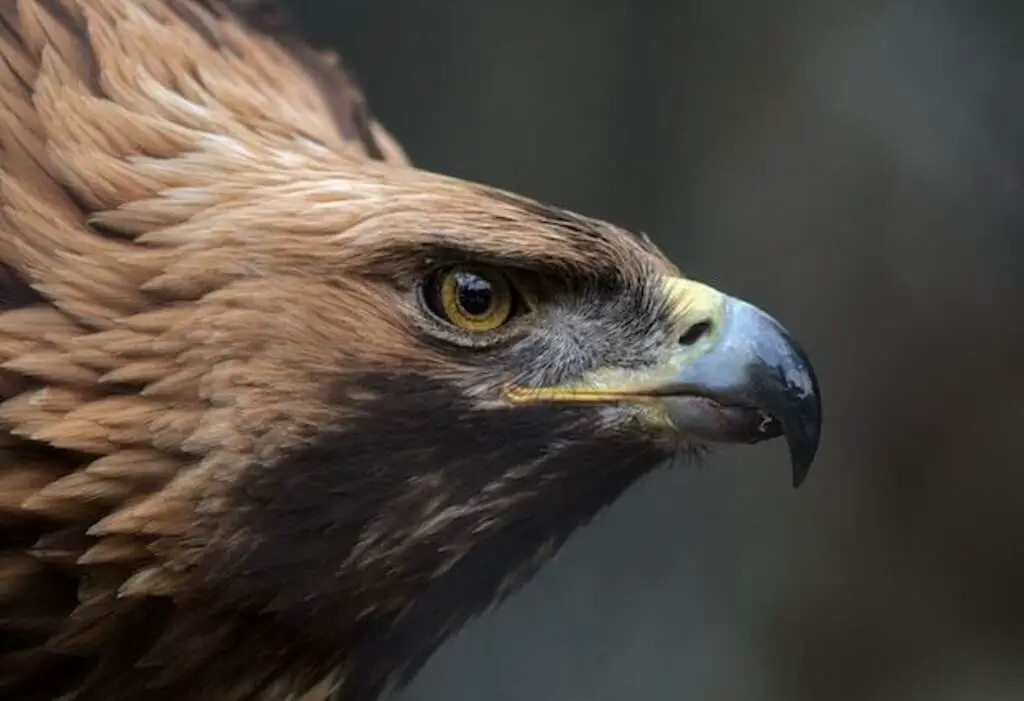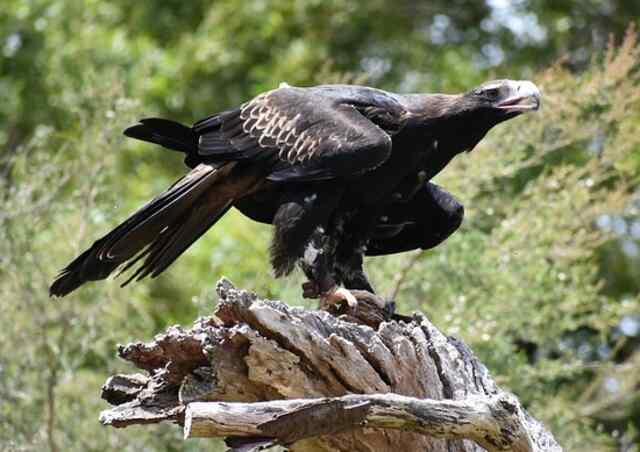Eagles, formidable avian predators, possess remarkable visual acuity, surpassing many other birds. Their eyes, like precision instruments, capture minute details, and they spot prey or threats from great heights.
Which eagle has the best eyesight? This article explores various species’ anatomy and visual capabilities to uncover the truth.
From Golden to Bald, Harpy to African Fish Eagle, we embark on a journey to determine the ultimate eagle with exceptional eyesight.
Let’s spread our wings of curiosity and soar into the realm of eagle vision, where the world takes on a whole new dimension.
Table of Contents
- 1 Key Takeaways
- 2 Which Eagle Has The Best Eyesight
- 3 The Anatomy of Eagle Eyes
- 4 The Golden Eagle
- 5 The Bald Eagle
- 6 The Harpy Eagle
- 7 The African Fish Eagle
- 8 The Steller’s Sea Eagle
- 9 The Martial Eagle
- 10 The Wedge-tailed Eagle
- 11 The White-tailed Eagle
- 12 The Philippine Eagle
- 13 Conclusion: The Ultimate Eagle with the Best Eyesight
- 14 Frequently Asked Questions
- 14.1 How does an eagle’s eyesight compare to that of other birds?
- 14.2 Are there any other factors besides eyesight that contribute to an eagle’s hunting abilities?
- 14.3 What is the average range of an eagle’s vision?
- 14.4 Can an eagle’s eyesight deteriorate with age?
- 14.5 Are there any specific adaptations in an eagle’s eyes that enhance their eyesight?
- 15 Author
Key Takeaways
- The Golden eagle has the highest resolution and visual acuity among all eagle species.
- Eagles have a visual acuity estimated to be four to eight times greater than that of humans.
- The African fish eagle has visual adaptations for hunting in coastal areas and has specially adapted eyes with a higher density of red cones to perceive colors more vividly.
- While both the Golden eagle and the African fish eagle possess remarkable visual abilities, the Golden eagle reigns supreme in terms of eyesight capabilities.
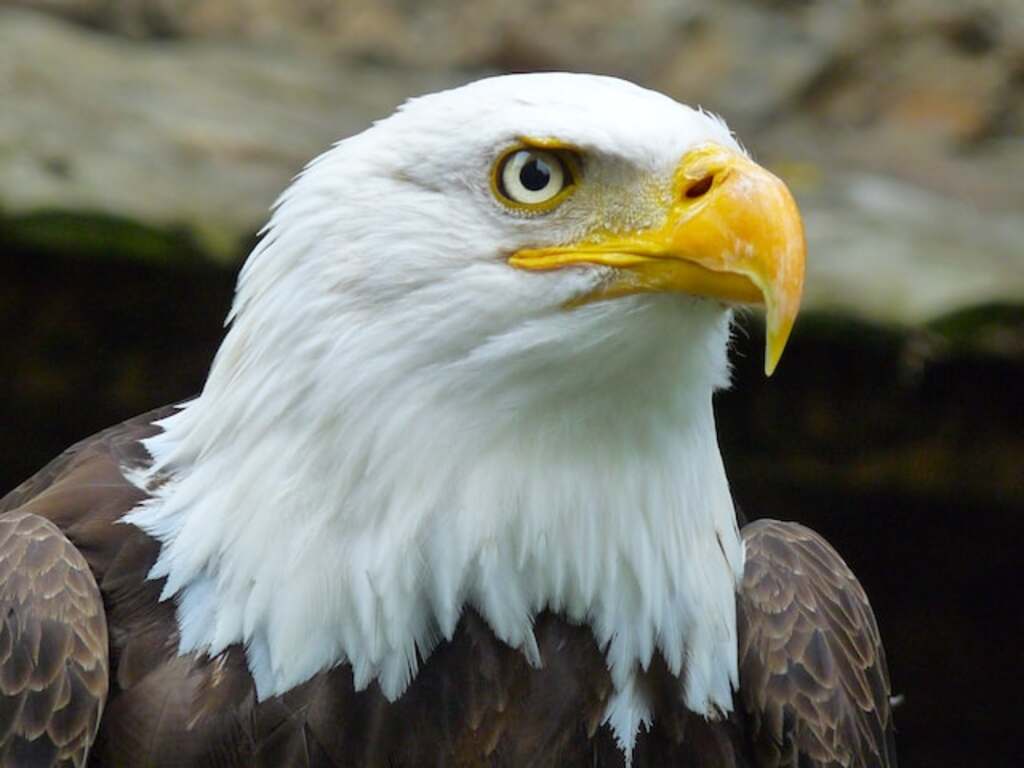
Which Eagle Has The Best Eyesight
The Golden Eagle has the best eyesight among eagles. With extraordinary visual acuity, it can spot prey from tremendous heights. Its eyes act like precision instruments, capturing minute details. Known for its keen vision, the Golden Eagle holds the title of the ultimate eagle with exceptional eyesight.
The Anatomy of Eagle Eyes
The anatomical structure of eagle eyes is characterized by a high concentration of cone cells, an enlarged cornea, and a deep fovea, which collectively contribute to their exceptional visual acuity.
Cone cells are responsible for color vision and are densely packed in the retina, allowing eagles to detect a wide range of colors.
The enlarged cornea provides a larger surface area for light to enter the eye, maximizing the amount of light that can be captured.
Additionally, the deep fovea, a small depression in the retina, allows for a high degree of visual acuity and is particularly useful for spotting small prey.
Different species of eagles have also developed adaptations for hunting in different environments, such as the bald eagle’s ability to spot fish from a long distance.
Transitioning to the subsequent section about the golden eagle, its eyesight is known to be especially remarkable.
The Golden Eagle
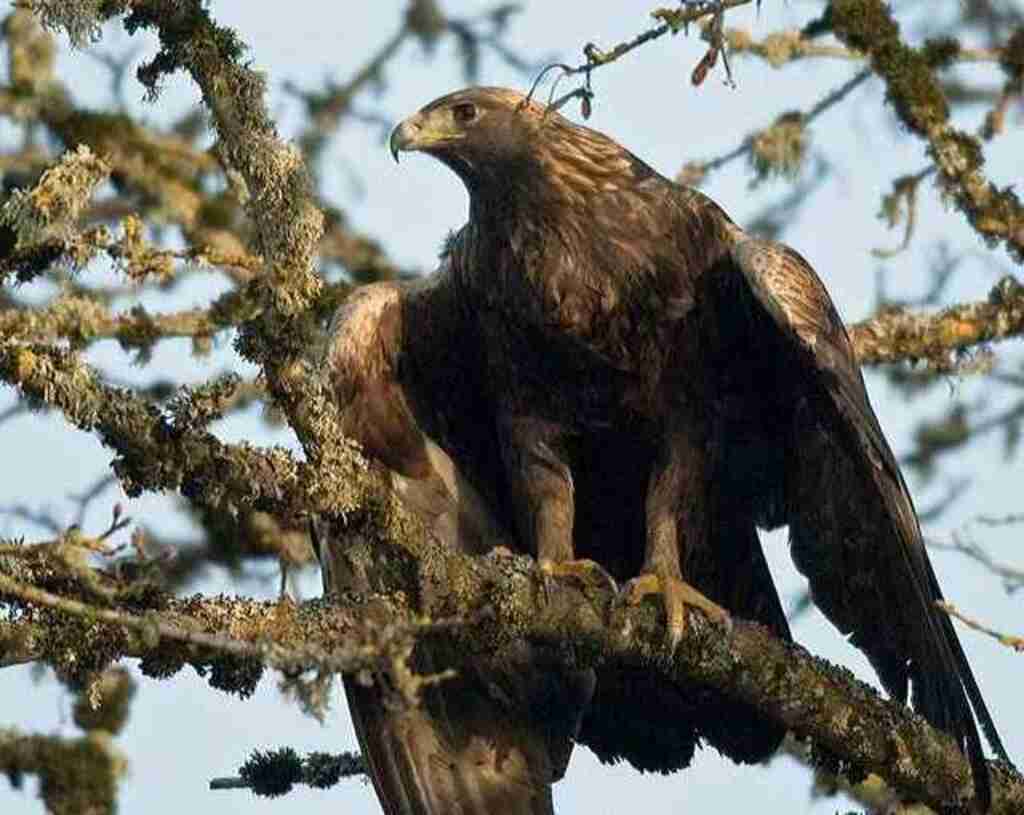
The Golden Eagle possesses an impressive visual range, allowing it to spot prey from great distances. This is due to its large eyes, which are adapted for excellent long-distance vision.
With its keen eyesight, the Golden Eagle is able to effectively scan vast landscapes and identify potential prey, such as small mammals or birds.
In terms of hunting techniques, the Golden Eagle primarily relies on its visual acuity to locate and pursue its prey, using its powerful talons to grasp and kill it.
Impressive Visual Range
With an impressive visual range, eagles possess the ability to spot prey from great distances, allowing them to accurately locate and capture their targets.
Their exceptional eyesight is due to several factors, including their large eyes, high number of photoreceptor cells, and specialized eye structures.
These adaptations enable eagles to see with incredible clarity and detail, even in low light conditions.
Their visual acuity is estimated to be four to eight times greater than that of humans, allowing them to spot small prey from miles away.
To put this into perspective, imagine standing on one end of a football field and being able to clearly see an object the size of a dime at the opposite end.
This extraordinary visual capability gives eagles a distinct advantage in their hunting endeavors, allowing them to successfully spot and capture prey from great distances.
Spotting Prey from Great Distances
Notably, the remarkable visual range of eagles allows them to effortlessly spot their prey from impressive distances, a skill that gives them a significant advantage in their hunting pursuits.
Eagles possess exceptional visual adaptations that contribute to their exceptional eyesight.
Their eyes are large and well-developed, providing them with a wide field of view and excellent depth perception.
Additionally, eagles have a high density of photoreceptor cells called cones in their retinas, which enable them to perceive fine details and distinguish colors.
These adaptations allow eagles to spot even small prey items from great distances, such as fish in water or small rodents on the ground.
Furthermore, eagles have the ability to focus their vision, allowing them to maintain clarity and accuracy while observing their surroundings.
This extraordinary visual acuity is essential for their hunting techniques, enabling them to locate and target their prey with precision.
Transitioning to the subsequent section about hunting techniques, eagles utilize various strategies to capture their prey.
Hunting Techniques
Eagles employ a range of hunting techniques, including aerial attacks and ambush strategies, to effectively capture their prey.
They have developed remarkable adaptations for hunting in different environments, such as coastal areas. For example, the osprey, also known as the sea eagle, is well-suited for hunting fish.
It has long, sharp talons and reversible outer toes that allow it to grasp slippery prey more securely. The bald eagle, another coastal hunter, also possesses unique adaptations.
Its sharp, curved beak is ideal for tearing into fish flesh, and its large, powerful wings enable it to soar high above the water before diving to snatch its prey.
These hunting techniques and adaptations make eagles highly efficient predators in their respective habitats.
Transitioning to the next section, the bald eagle exhibits not only exceptional hunting skills, but also fascinating characteristics that set it apart from other eagles.
The Bald Eagle
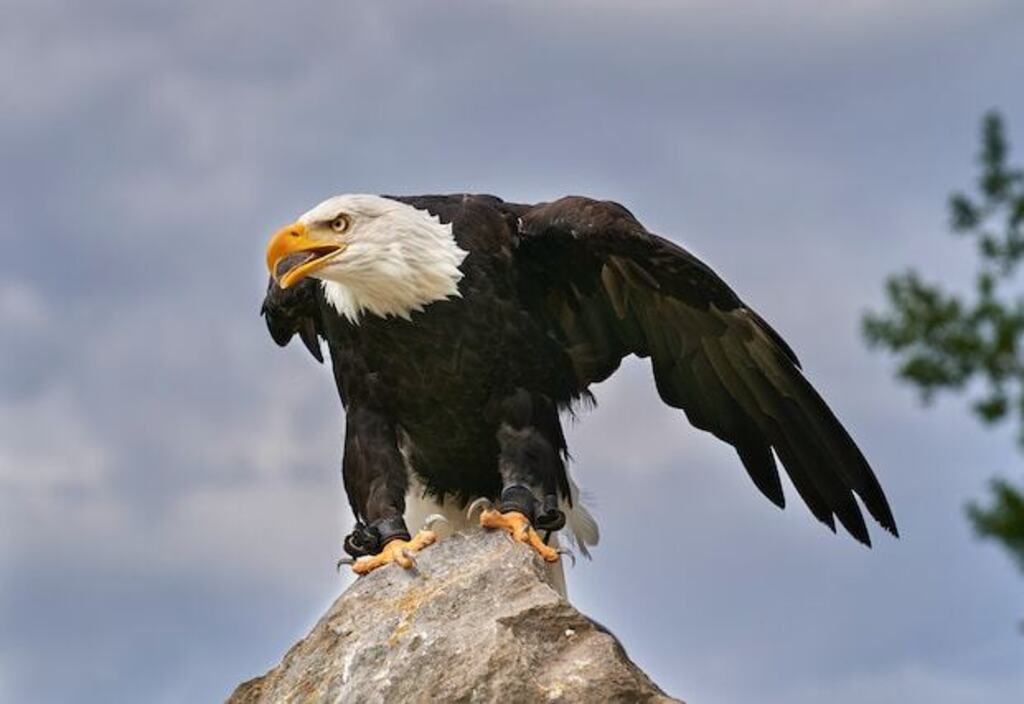
Renowned for its keen eyesight, the Bald Eagle captivates with its ability to spot prey from great distances. The visual adaptations of the Bald Eagle are remarkable and contribute to its superior vision.
Its large eyes, positioned at the front of its head, provide a wide field of view, allowing it to scan the surroundings effectively.
The eagle’s eyes are equipped with a high density of cone cells, which are responsible for color vision and visual acuity.
This enables the Bald Eagle to discern even the smallest details, such as the movement of fish beneath the water’s surface.
Additionally, the eagle’s eyes have a higher number of rod cells, which enhance its ability to see in low light conditions.
With such remarkable visual adaptations, the Bald Eagle demonstrates its prowess as a skilled hunter.
Transitioning to the subsequent section about the harpy eagle, this species also exhibits extraordinary visual abilities.
The Harpy Eagle
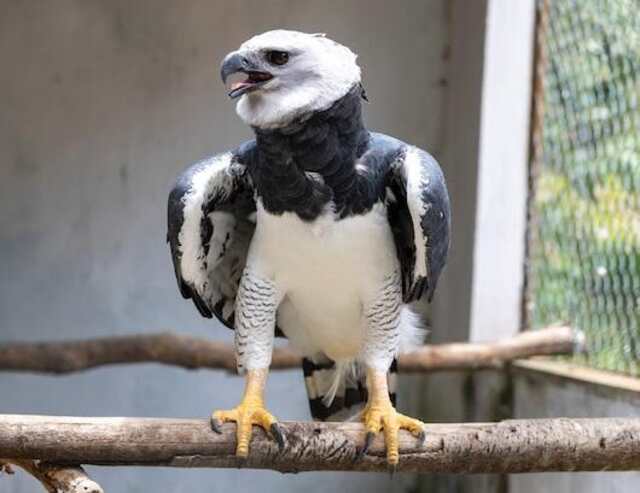
The Harpy Eagle, with its impressive visual abilities, is able to spot prey from great distances due to its exceptional eyesight.
This eagle, found in the tropical rainforests of Central and South America, possesses a unique combination of characteristics that contribute to its exceptional aerial abilities.
With a wingspan of up to 7 feet, it can soar through the forest canopy with ease, utilizing its keen eyesight to locate and capture prey such as monkeys and sloths.
Additionally, the Harpy Eagle exhibits unique nesting habits, building its nests high up in the tallest trees, providing it with an advantageous vantage point for hunting.
Its exceptional eyesight and aerial abilities make the Harpy Eagle a formidable predator in its environment.
Transitioning to the subsequent section, the African Fish Eagle also showcases remarkable visual capabilities.
The African Fish Eagle
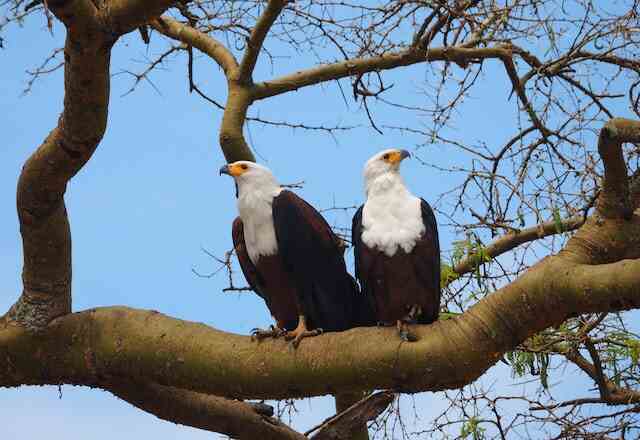
The Harpy Eagle, known for its impressive size and strength, is not the only eagle with exceptional eyesight.
Another eagle species known for its acute vision is the African Fish Eagle. This majestic bird, found in sub-Saharan Africa, possesses anatomical adaptations that contribute to its exceptional eyesight.
Its large eyes are positioned at the front of its head, providing a wide field of vision and depth perception.
Additionally, the eagle’s retinas have a high density of cone cells, which are responsible for color vision and detail detection.
The African Fish Eagle’s exceptional eyesight aids its hunting strategies, allowing it to spot fish from great distances while soaring above rivers and lakes.
It then uses its sharp talons and hooked beak to catch and consume its prey.
As we move on to explore the next eagle species, the Steller’s Sea Eagle, we will discover yet another remarkable example of avian eyesight.
The Steller’s Sea Eagle
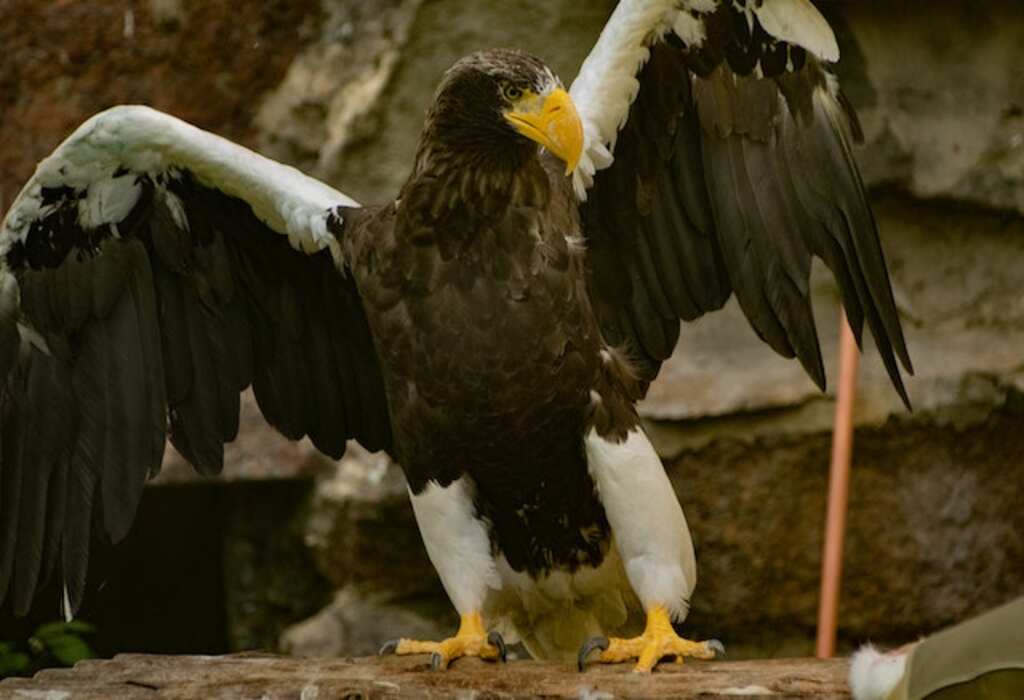
Notably, the Steller’s Sea Eagle possesses remarkable visual acuity, which astounds with its ability to spot prey from immense distances, leaving observers in awe of its hunting prowess.
This species has developed several anatomical adaptations that contribute to its exceptional eyesight.
Its large eyes are equipped with a high number of light-sensitive cells called cones, allowing for precise color vision and the detection of fine details.
Additionally, the eagle’s pupils are capable of dilating to gather more light in low-light conditions, enhancing its vision during dawn and dusk hunting activities.
The Steller’s Sea Eagle primarily relies on its impressive eyesight to locate and capture prey along coastal areas, where it employs various hunting strategies such as soaring above the water surface or perching on elevated positions.
These adaptations and hunting techniques make the Steller’s Sea Eagle a formidable predator in its environment.
Consequently, the subsequent section will explore the visual capabilities of the martial eagle.
The Martial Eagle
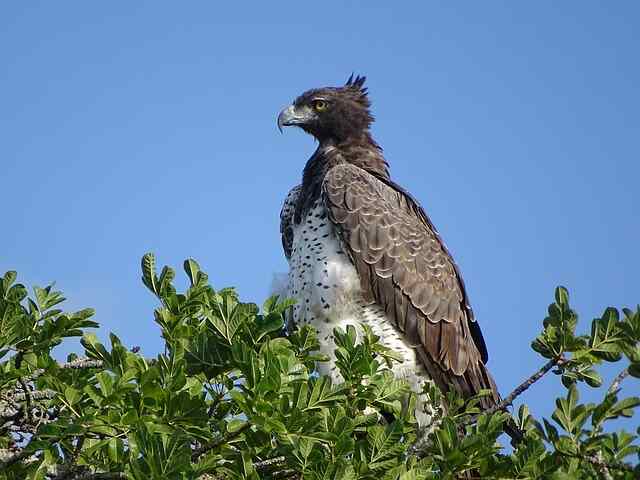
With its remarkable visual acuity and anatomical adaptations, the Martial Eagle demonstrates exceptional hunting prowess.
This bird of prey possesses a large, flat head with forward-facing eyes, which allows for binocular vision and enhances depth perception.
The Martial Eagle’s eyes are equipped with a dense concentration of cone cells, specialized photoreceptor cells that enable color vision and high visual acuity.
Additionally, the eagle’s eyes are protected by a bony ridge known as the supraorbital ridge, which shields them from glare and potential injuries during hunts.
In terms of hunting techniques, the Martial Eagle relies on its exceptional eyesight to spot prey from great distances. It often perches on high vantage points, scanning the landscape for potential targets.
Once a prey is spotted, the eagle employs its powerful talons and sharp beak to capture and kill its quarry swiftly.
The Martial Eagle’s visual adaptations and hunting techniques make it a formidable predator in its habitat.
Transitioning to the subsequent section about ‘the wedge-tailed eagle,’ this species also possesses remarkable visual abilities and unique hunting strategies.
The Wedge-tailed Eagle
Characterized by its distinct wedge-shaped tail, the Wedge-tailed Eagle soars through the skies with the piercing gaze of a sentinel, its eyes penetrating the vast expanse of the landscape below.
Anatomy studies have revealed that the Wedge-tailed Eagle possesses exceptional visual acuity, allowing it to spot even the smallest movement from great distances.
Its eyes are large relative to its body size, providing a wide field of vision.
This, coupled with a high concentration of cone cells in the retina, enables the eagle to perceive fine details and distinguish colors with precision.
The Wedge-tailed Eagle’s hunting behaviors are also influenced by its remarkable eyesight.
It uses its keen vision to locate prey and assess its vulnerability, often targeting small to medium-sized mammals, reptiles, and birds.
With its superior visual capabilities, the Wedge-tailed Eagle effortlessly scours the landscape, ready to seize any opportunity that presents itself.
Transitioning to the subsequent section about the white-tailed eagle, this majestic bird of prey also exhibits exceptional visual prowess.
The White-tailed Eagle
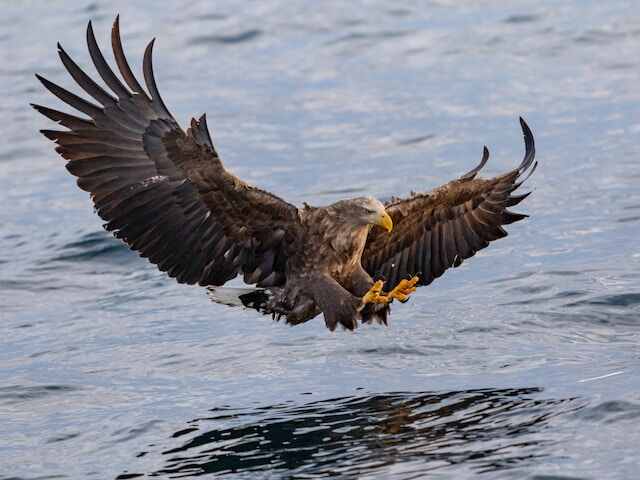
The White-tailed Eagle, also known as the sea eagle, exhibits visual adaptations specifically tailored for hunting in coastal areas.
These adaptations enable them to spot fish and birds from long distances, allowing them to effectively locate and capture their prey.
Additionally, the White-tailed Eagle employs various hunting techniques that rely on their exceptional eyesight, such as aerial hunting and surprise attacks from perches.
Visual Adaptations for Hunting in Coastal Areas
Visual adaptations for hunting in coastal areas include a highly developed visual acuity and specialized eye structures in order to spot prey from a distance.
The White-tailed Eagle, with its impressive wingspan and sharp eyesight, has adapted to its coastal habitat by possessing certain anatomical features and employing specific hunting strategies.
One such adaptation is its large eyes, which allow for better light reception and increased visual sensitivity.
Additionally, the position of the eyes on the front of the eagle’s head provides binocular vision, enabling accurate depth perception and precise targeting of prey.
The eagle’s retina is also equipped with a high concentration of light-sensitive cells called cones, which enhance color vision and facilitate the detection of subtle movements.
These visual adaptations enable the White-tailed Eagle to spot fish and birds from long distances, giving it a distinct advantage in its coastal hunting environment.
Spotting Fish and Birds from Long Distances
Eagles are known for their exceptional eyesight, which enables them to spot prey from great distances.
This visual adaptation is particularly important for eagles that hunt in coastal areas, where their main sources of food, such as fish and birds, are often located in open water or on the shoreline.
To successfully hunt in these environments, eagles have developed a set of hunting techniques that take advantage of their acute vision.
They soar high above the water, scanning the area for any signs of movement or disturbances.
Once a potential target is spotted, the eagle can rapidly descend towards it, using its sharp talons to capture the prey.
This combination of powerful eyesight and effective hunting techniques allows eagles to thrive in coastal ecosystems.
Transitioning into the subsequent section about ‘hunting techniques’, eagles employ a range of strategies to secure their next meal.
Hunting Techniques
One impressive aspect of their hunting strategies involves the utilization of various techniques to successfully secure their next meal.
Eagles possess remarkable visual adaptations that enable them to spot prey from great distances. Their sharp, binocular vision allows them to accurately judge the distance and size of their target.
Additionally, their eyes are equipped with a high concentration of light-sensitive cells called cones, which enhance their ability to perceive colors and details.
Eagles employ a range of hunting techniques depending on their environment and prey. They may engage in soaring, where they circle high in the sky, scanning the ground for potential targets.
They can also employ a stooping technique, where they dive at high speeds to catch their prey by surprise.
These hunting techniques demonstrate the agility and adaptability of eagles in their pursuit of food.
Transitioning into the subsequent section about the Philippine eagle, this species showcases its own unique hunting strategies.
The Philippine Eagle

The Philippine Eagle, also known as the Monkey-eating Eagle, possesses impressive visual acuity and range. With its large eyes and sharp vision, it is able to spot prey from great distances and accurately target its prey while in flight.
This visual acuity is particularly useful when hunting in dense rainforests, where the eagle must navigate through thick vegetation to capture its prey.
Additionally, the Philippine Eagle has unique feeding habits, as it primarily feeds on large mammals such as monkeys and flying lemurs, making it one of the few raptor species known to hunt and feed on such prey.
These distinctive characteristics contribute to the Philippine Eagle’s status as one of the most remarkable and specialized birds of prey in the world.
Impressive Visual Acuity and Range
Impressive visual acuity and range are hallmarks of the eagle’s eyesight, allowing for exceptional long-distance vision and the ability to spot prey from great heights.
The Philippine Eagle, for instance, possesses some of the most remarkable visual capabilities among eagles.
To further illustrate the extraordinary nature of their eyesight, consider the following:
- Binocular vision: Eagles have overlapping visual fields, resulting in enhanced depth perception and accurate judgment of distances.
- Retinal adaptations: These birds have a higher number of cones, specialized photoreceptor cells responsible for color vision and visual acuity, compared to humans.
- Visual acuity: The eagle’s visual acuity is estimated to be 20/5 or even better, surpassing human capabilities.
- Visual range: Eagles can detect UV light, expanding their visual spectrum and enabling them to perceive fine details.
With such remarkable visual abilities, eagles are adept at hunting in dense rainforests, where their sharp eyesight allows them to navigate and locate prey even in challenging environments.
Hunting in Dense Rainforests
With their exceptional visual acuity and range, how do eagles navigate and locate prey in the dense rainforests?
Eagle hunting techniques in rainforests involve a combination of visual adaptations for hunting.
To overcome the challenges posed by the dense vegetation, eagles rely on their sharp eyesight and acute vision.
They possess specialized adaptations, such as a high number of photoreceptor cells called cones, which enable them to perceive colors and details with great precision.
Additionally, eagles have a wide field of view due to their eyes being positioned towards the sides of their head, allowing them to scan a larger area for potential prey.
These visual adaptations, combined with their ability to fly swiftly and silently, enable eagles to maneuver through the dense rainforest foliage and accurately spot prey.
Transitioning into the subsequent section about unique feeding habits, eagles utilize their exceptional eyesight to successfully capture and consume their prey.
Unique Feeding Habits
Adapting to their rainforest environment, eagles display remarkable feeding habits that showcase their ability to effectively capture and consume prey.
These majestic birds exhibit diverse feeding preferences, which are largely influenced by their hunting strategies.
Rainforest eagles have been observed to favor a wide range of food sources, including small mammals, reptiles, amphibians, and birds.
Their hunting strategies often involve a combination of aerial pursuits, stealthy approaches, and surprise attacks.
For instance, some species of rainforest eagles are known to soar high above the canopy, scanning for potential prey with their keen eyesight, before diving with incredible speed to seize their target.
Others employ a more patient approach, perching on tree branches and waiting for an opportunity to ambush unsuspecting prey below.
These unique feeding habits highlight the adaptability and resourcefulness of rainforest eagles in securing their sustenance.
Transitioning seamlessly into the subsequent section about the ultimate eagle with the best eyesight, it becomes evident that the feeding preferences and hunting strategies of these birds directly contribute to their exceptional visual acuity.
Conclusion: The Ultimate Eagle with the Best Eyesight
In terms of eyesight, the Golden eagle holds the distinction for having the highest resolution and visual acuity among all eagle species, with the ability to spot a rabbit from a distance of up to two miles.
This exceptional eyesight is essential for the Golden eagle’s hunting techniques, which involve spotting and capturing prey from great heights.
Additionally, the African fish eagle has developed visual adaptations for hunting in coastal areas.
With specially adapted eyes that contain a higher density of red cones, the African fish eagle is able to perceive colors more vividly, allowing it to spot fish swimming beneath the water’s surface.
These adaptations give the African fish eagle an advantage in locating and catching its prey.
Overall, while both the Golden eagle and the African fish eagle possess remarkable visual abilities, it is the Golden eagle that reigns supreme in terms of eyesight capabilities.
Frequently Asked Questions
How does an eagle’s eyesight compare to that of other birds?
Eagle vision exhibits evolutionary advantages over human vision due to their larger eyes, higher density of photoreceptors, and specialized structures. These adaptations enhance their ability to detect prey from great distances and perceive fine details.
Are there any other factors besides eyesight that contribute to an eagle’s hunting abilities?
Eagle hunting techniques are influenced by various factors, including habitat. For example, the Golden Eagle’s ability to hunt in open areas allows it to spot prey from a distance, while the Harpy Eagle’s agility in dense forests enables it to ambush prey effectively.
What is the average range of an eagle’s vision?
The average range of an eagle’s vision extends up to 5 kilometers. Eagles possess high visual acuity due to the density of photoreceptor cells in their retinas, allowing them to detect prey from long distances.
Can an eagle’s eyesight deteriorate with age?
Aging can have an impact on an eagle’s eyesight, as it can lead to a gradual decline in visual acuity. This deterioration may be due to factors such as cataracts, retinal degeneration, and reduced lens flexibility.
Are there any specific adaptations in an eagle’s eyes that enhance their eyesight?
Eagle eyesight adaptations enable them to spot prey effectively. They have large, binocular vision that enhances depth perception, and a high density of photoreceptor cells called cones in their retina, allowing for excellent visual acuity and color vision.

